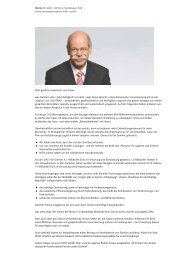Dear readers, This report describes what Daimler means by ...
Dear readers, This report describes what Daimler means by ...
Dear readers, This report describes what Daimler means by ...
You also want an ePaper? Increase the reach of your titles
YUMPU automatically turns print PDFs into web optimized ePapers that Google loves.
<strong>Daimler</strong> 360 GRAD - FAKTEN zur Nachhaltigkeit 2008<br />
<strong>Daimler</strong> Nachhaltigkeitsbericht 2008 / Environmental protection, innovation, and safety / Production / Energy and climate protection<br />
� Another very successful measure involved a reduction of suction flow volumes in processing machines with<br />
the help of computer-based simulation calculations. The optimizations achieved here lowered such flow<br />
volumes <strong>by</strong> 20–30 percent, saving 30,000 megawatt-hours of energy.<br />
� Ventilation at one production hall was adjusted to conform to actual needs <strong>by</strong> using a more efficient<br />
ventilation system and new electronically controlled motors. <strong>This</strong> resulted in annual savings of 1,200<br />
megawatt-hours of electricity and 3,800 megawatthours of heat.<br />
� A key administrative measure was a synchronization of ventilation and lighting with actual production times,<br />
using an operating-time system. <strong>This</strong> led to annual savings of 21,000 megawatt-hours of electricity and<br />
27,000 megawatt-hours of heat.<br />
� Increased employee awareness of the need to conserve energy also yielded savings, with Intranet campaigns<br />
and posters and flyers sensitizing employees and encouraging them to get involved.<br />
� A newly introduced sticker identifies “disengageable machines,” making staff more aware of equipment that<br />
can be completely shut down when not being used for production.<br />
Specific CO 2 emissions from production<br />
Altogether, in 2007 the energy efficiency project in Untertürkheim reduced electricity consumption <strong>by</strong> 51,700<br />
megawatt-hours and heat consumption <strong>by</strong> 130,200 megawatt-hours compared to the reference year of 2005.<br />
The project also cut water consumption <strong>by</strong> 500,000 cubic meters. In recognition of these accomplishments, the<br />
project team was presented with <strong>Daimler</strong>’s Environmental Leadership Award (ELA) in November 2007.<br />
CO 2 emissions. Total energy-related CO 2 emissions at all plants decreased <strong>by</strong> 2.7 percent to 3.78 million tons in<br />
2007 (see chart above). The lower decline in emissions compared to energy consumption was due to the fact<br />
that particularly high savings were achieved in the areas of fuels and district heating requirements, while<br />
consumption of electrical energy, which accounts for a high proportion of indirect CO 2 emissions, rose slightly.<br />
The graph above left, which shows CO 2 emissions from production plants in relation to the number of vehicles<br />
produced, makes it clear that energy-saving projects at the Mercedes-Benz Cars were already beginning to have<br />
an impact in the second year of implementation. Thanks to new and efficient production equipment and a sharp<br />
increase in production, the Group’s “Vans, Buses, Other” segment once again recorded lower specific CO 2<br />
emissions than in the prior year. At the same time, the specific CO 2 figures for <strong>Daimler</strong> Trucks rose due to the<br />
decline in production at that division.<br />
Emissions of other greenhouse gases, such as coolants, are negligible. The greenhouse effect resulting from such<br />
gases is less than one one-thousandth of the total figure for greenhouse gas emissions generated <strong>by</strong> <strong>Daimler</strong>.














